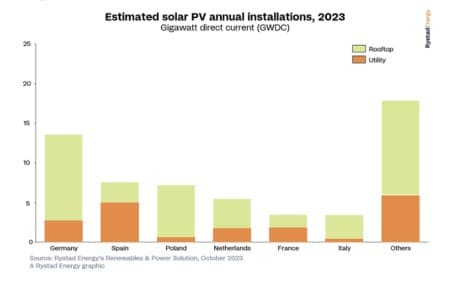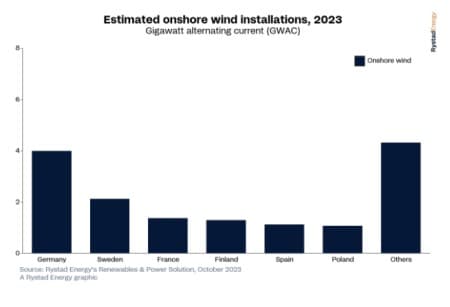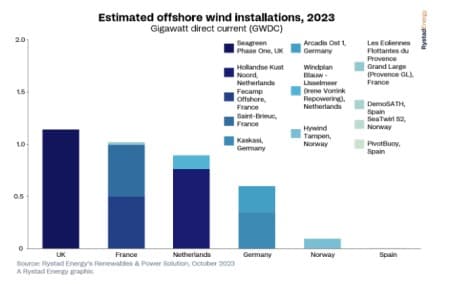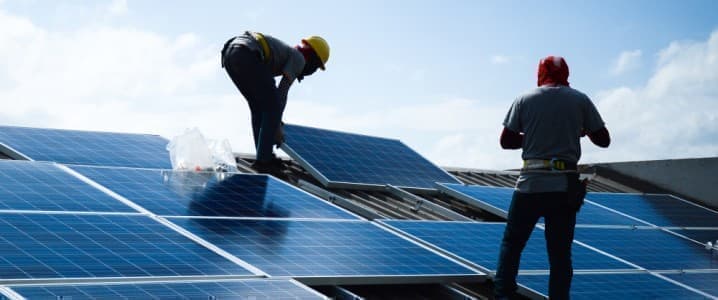Europe's solar installation levels are exceeding expectations, with the amount installed in October 2023 already matching the total installed in all of last year. Rystad Energy modeling forecasts new solar capacity additions will grow 30% this year versus 2022, surpassing 58 gigawatts direct current (GWDC) of new panels by the end of the year.
This year, rooftop solar installations have taken the lead, accounting for 70% of all newly installed solar in Europe. This underscores the continent's commitment to clean energy and the adaptability of solar photovoltaic (PV) technology, which can be deployed quickly with comparatively few regulatory hurdles, relative to large-scale, ground-mounted projects.
After briefly conceding top position to Spain last year, Germany is surging ahead with a projected 84% annual growth this year, reaching a record high of 13.5 GWDC of total solar PV capacity. By contrast, Spain faces challenges in maintaining momentum this year, despite its record-breaking performance in 2022. Other key emerging markets include Poland and the Netherlands, with their growth primarily fueled by a surge in rooftop installations, a trend that is gaining traction across the continent.
Rooftop solar is driving the transformation of Europe's renewable energy landscape, from a niche market to a powerful force in reshaping the continent's energy mix. However, wind energy – including onshore and offshore, both of which were previously on a robust growth path – has faced hurdles that could hinder its expansion. These evolving trends present both challenges and opportunities for Europe as it races to decarbonize while maintaining a stable energy supply
Vegard Wiik Vollset, vice president and head of EMEA renewables research, Rystad Energy

Learn more with Rystad Energy’s Renewables & Power Solution.
Wind energy will be a fundamental piece of Europe’s clean power puzzle in the years to come, but onshore wind is facing some significant hurdles. Permitting bottlenecks and rising supply chain costs are holding developments back, causing an estimated 11% drop in new installations in 2023 compared to last year. Offshore wind capacity is expected to grow this year, but only by 2% due to project delays.
This downturn is driven by a confluence of adverse factors, including inflationary pressures, cumbersome permitting processes and escalating interest rates. Germany, however, continues to make progress in its wind capacity growth despite these hurdles. After a lackluster 2022, Germany is expected to bring nearly 4 gigawatts (GW) of new onshore wind capacity online, marking steady growth and further demonstrating the country’s strategy to maintain a balanced commitment to having a diversified renewable energy portfolio.
Other major players in the onshore wind sector are not faring so well. While Sweden and France have managed to somewhat mitigate the downturn with reductions in annual installed capacity of 16% and 15%, respectively, the outlook is far bleaker for the likes of Finland, Spain and Poland, with these three nations all projected to experience annual decreases in annual installed capacity exceeding 30%.

The European offshore wind sector has seen a modest 2% annual growth in installations for this year. Offshore wind was on a strong upward trajectory, but a recent spate of delays to key projects has highlighted the vulnerability of the market. In the past two months, several developers and governments have announced delays or potential cancellations of projects in the UK and Denmark. The causes include increasing development costs, difficulty in securing desirable offtake deals and regulatory changes.
As a result, these two nations are now expected to miss their 2030 offshore wind targets by a larger margin than previously anticipated. For example, the UK is now expected to reach a maximum of 46.8 GW of offshore wind capacity by 2030, missing its governmental target of 50 GW. Similarly, Denmark is now expected to reach slightly over 10 GW, below its target of 12 GW.
Despite the obstacles faced, the offshore wind industry perseveres, showcasing its resilience and long-term promise. France, a relative newcomer in this arena, has made its presence felt with the commissioning of its inaugural offshore wind facilities, Saint-Brieuc and Fecamp. Furthermore, the world's largest floating offshore wind farm, Equinor's 88-megawatt (MW) Hywind Tampen off the coast of Norway, commenced operations this year, signifying a noteworthy technological leap forward for the sector.
The question now is whether offshore wind can get back on a growth trajectory. This will require considerable changes to project development and permitting processes as well as continued investment in research and development to keep costs affordable while maintaining efficiency. Given the sector's strong potential to contribute to decarbonization and economic growth, however, there is a strong incentive to overcome these challenges.

More Top Reads From Oilprice.com:
- Israel And Interest Rates Keep Oil Prices Erratic
- Gold Nears $2,000 Amid Global Tensions
- Researchers Unveil Catalyst To Convert CO2 Into Methane


















